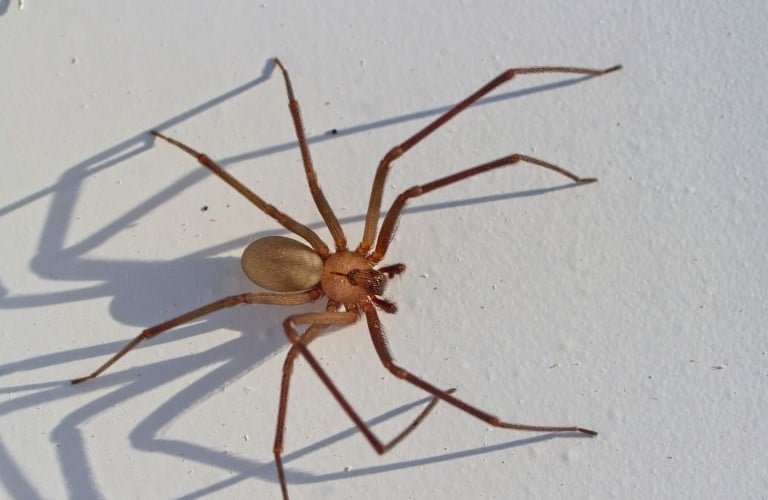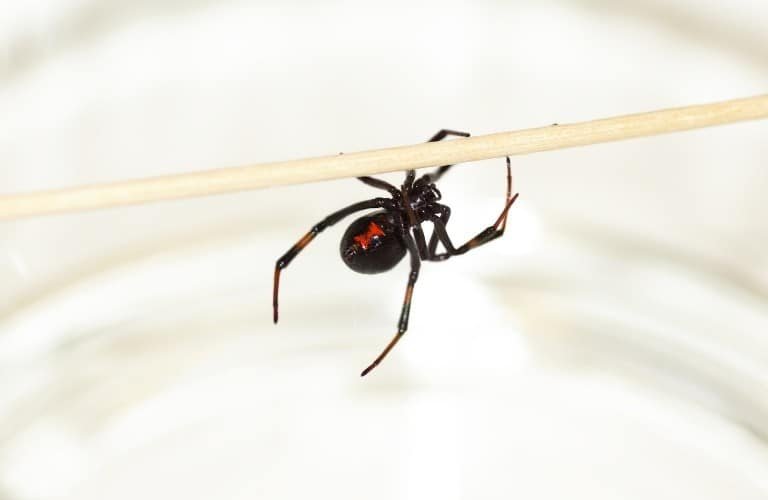The Midwestern United States is home to numerous species of spiders. Most of these species are relatively harmless and are not aggressive.
There are a few types of spiders in the Midwest, however, that are dangerous to humans and should be avoided.
What is the deadliest spider in the Midwest? The deadliest spider in the Midwest is either the brown recluse spider or the black widow spider. Though both have powerful venom and are relatively common to the Midwest, neither cause many human deaths.
While the chances are favorable that you will never be seriously harmed by spider, knowing how to identify the more dangerous ones common to your area is wise and will help you avoid any unnecessary close encounters.
You’ll find detailed prevention guidelines, effective elimination practices, recommended products, and more on our spider page. Don’t miss it!
Brown Recluse
Description
Brown recluse spiders can range in color from white/translucent to almost black. Most brown recluse spiders, however, are light to medium brown.
The cephalothorax and abdomen (the two body segments common to spiders) are often differing colors.
Note that spiders do not have the three body segments that insects do, and thus are not part of the insect classification. So, what are they? Find the answer here.
Also known as a “fiddleback spider,” “brown fiddler,” or “violin spider,” brown recluses have a characteristic marking that looks like a violin on their back.
The marking becomes darker and more defined as the spider matures, meaning some young spiders only have a faint outline.
This pattern is not the best way to determine whether or not a spider is a brown recluse, as many other spider varieties have the violin-like marking.
Instead, look at the brown recluse spider’s eyes. While most spiders have eight eyes, brown recluses only have six eyes.
There are very few spider species that have only three pairs of eyes.
They usually grow to be a quarter of an inch to a full inch, though some reach a full inch in length and width, and have short hairs all over their abdomen that help them feel their way around.
A female brown recluse only needs to be fertilized once and is able to produce viable eggs for the rest of her life.
Typically, she will produce about 150 babies per year, enough to thoroughly infest a home within a couple of years if left undiscovered.
If you suspect your home has fallen victim to a brown recluse infestation, take steps to eliminate them right away.
(Our article “How To Get Rid of Spiders Quickly” outlines the best comprehensive approach.)
For serious problems, a pesticide may be the best course of action. Foggers designed specifically for spiders, like Hot Shot Fogger with Odor Neutralizer, can be very effective.
Hot Shot keeps on killing for up to two months, thanks to its residual properties, and is very easy to use.
Visit our article “Best Fogger for Spiders” to view all of the foggers that we found to work on spiders.
Miss Muffet’s Revenge is a residual pesticide for long-term spider control.
In fact, if applied correctly, it will keep protecting your home for up to 12 months after just one application.
You may have heard that spraying a spider with hairspray is the best way to safely kill them.
Though this technique can prove fatal, it’s generally not the best approach to take when dealing with a dangerous spider.
Habits
Brown recluse spiders hide in dark, secretive locations, such as:
- Closets.
- Shoes.
- Structures.
- Trash cans.
- Wood stacks.
- Cardboard boxes.
This is one of the primary ways it moves from location to location: by hiding in an item that gets moved.
This is a problem with brown recluse spiders. Because they are so reclusive, it is difficult to know when they have entered your home until it is too late.
They are hardy and can survive for long periods of time without eating.
Brown recluse spiders are not aggressive, preferring to go unnoticed by humans. They usually only bite when provoked repeatedly.
However, sometimes humans inadvertently provoke a brown recluse, like if the spider is hiding in clothing or bedding.
Brown Recluse Bite
Most brown recluse bites heal quickly and without medical treatment.
Some bites, however, cause a small white blister, hardened tissue, blueish-gray wounds, and red, ragged edges.
The wound might stay open and become gangrenous, causing infection within a month of the bite.
Immediate symptoms of a brown recluse bite might include:
- Chills.
- Fever.
- Nausea.
- Itching.
- Sweating.
The seriousness of the bite depends on several factors including the spider’s maturity, the recipient’s sensitivity, and how quickly it gets noticed.
Black Widow
Description
The name black widow is used to describe three different spiders in North America and over thirty distinct spider species around the world.
In the Midwestern United States, the black widow is the Latrodectus mactans, also known as the “southern black widow” or “shoe-button spider.”
Female black widows are the more easily distinguished gender, as they have shiny black bodies with a red hourglass-shaped mark on the bottom of their abdomen.
Females are about 1 1/2 inches long, while males are only half that size.
Juvenile black widows range in color from gray to black and sometimes have white stripes across their body with orange or yellow spots.
Male black widows can look like juveniles or can be purple-colored.
Female black widows often live for up to three years, while males only survive a couple of months.
This is partly due to the fact that females often kill and eat the male after mating, giving them their name of “black widow.”
Between 200 and 900 eggs are hatched in each sac, but the babies are cannibalistic and only about half the new spiders survive into adulthood.
Most black widows eat a variety of insects, but have a special preference for fire ants if they are present.
Otherwise, moths, millipedes, and roaches are common prey for black widows.
Habits
The black widow’s web is three dimensional and is made with surprisingly strong webbing.
In fact, it is so strong that it has been known to trap larger victims, such as mice.
Like the brown recluse, black widows catch prey in their web. Generally, black widows eat mosquitoes, grasshoppers, beetles, caterpillars, millipedes, flies, and moths.
The spider then ensnares the prey by wrapping them up in more silk, uses its fangs to bite the prey, and injects venom to kill it.
Typically, black widow spiders are found in locations where they can be undisturbed and warm:
- Barns.
- Basements.
- Garages.
- Dry wood.
- Compost piles.
- Underneath manmade structures.
If your barn, garage, or other outbuilding if full of spider webs and cobwebs, read this to learn how to quickly and safely reclaim your space.
While the above-mentioned Miss Muffet’s Revenge will, in all likelihood, get the job done in terms of eliminating black widows, you may wish for a slightly more potent pesticide.
Ortho Home Defense contains bifenthrin, just like Miss Muffet’s, but it has the extra power of zeta-cypermethrin as well.
This product offers up to 12 months of protection and is nonstaining, odor free, and fast drying.
A comfort wand is included for easy application and a continuous spray.
Black Widow Bite
Black widows are widely considered to be the most venomous spider in North America, with venom up to fifteen times stronger than a rattlesnake’s.
However, only the female’s bite is a threat to humans, as the male does not have the venom capacity to cause a fatal bite.
Like the brown recluse, black widows rarely kill humans. Their bites are dangerous, however, to young people, elderly people, and those with preexisting sicknesses.
When bitten, most people feel like they’ve been stuck with a pin.
Severe cases feel the venom spreading to the rest of the body, producing sweating, back and abdomen pain, muscle aches, racing heartbeat, and difficulty breathing.
There is a black widow antivenom that helps ease the symptoms and decrease the likelihood of long-term effects.
If You Have Been Bitten
Even though these spiders have a high concentration of powerful venom, they are not as dangerous as they sound.
The reality is that an average of seven people die in the United States each year from spider bites.
Part of the reason these spiders struggle to deliver enough venom to humans is that their mouths are designed to harm much smaller prey.
They do not have the ability to puncture human skin deeply or widely enough to spread the venom throughout the body.
If you are bitten by a spider that you think might contain venom like the brown recluse or black widow, immediately contact medical professionals.
If you can do it safely, it is helpful to bring the spider in for identification.
It is recommended that you pay attention to items that have been in storage for a long time, as these might be nests for brown recluses or black widows.
Find out exactly what to do if you happen to run across a black widow spider in this article.
What Is the Deadliest Spider in the World?
The genus Phoneutria contains eight different spiders in Central and South America.
Known as armed spiders or Brazilian wandering spiders, these spiders do not use a web to catch prey.
Instead, they use their quickness and extremely powerful venom to kill prey.
They grow to have a leg span of 5 to 7 inches and have the heaviest body of any spider of their kind.
These spiders are fighters rather than runners; while most spiders use venom to subdue prey, the armed spider uses it as a defense mechanism.
They fight back tirelessly against any predator, preferring biting instead of fleeing. They eat insects, other spiders, small amphibians, reptiles, and mammals.
Like the black widow spider, females will occasionally attack, kill, and eat the male after mating.
Even this spider, however, is only recorded to have killed 10 humans in the last 100 years, primarily due to its lack of domestication and wild habitat.
Summary
The brown recluse spider and black widow spider are common to most Midwest states and are the most dangerous you can find.
However, they do not cause many human deaths and are often healed without medical treatment.
If you have been bitten by a spider that you think is venomous, immediately call 911 or contact a health care professional to determine the best course of action.
Be sure to check out all our spider articles. You’ll discover a wealth of information, interesting facts, prevention measures, and elimination strategies. Access them all here.








